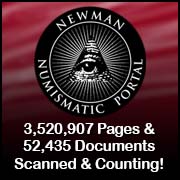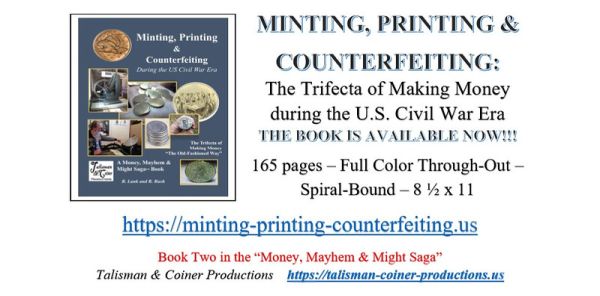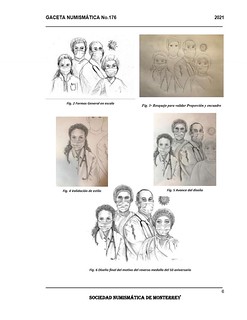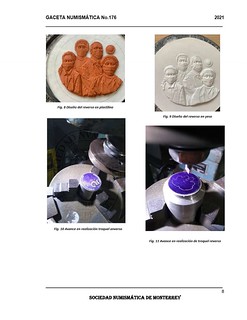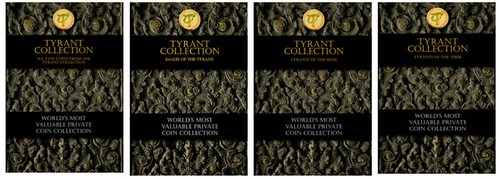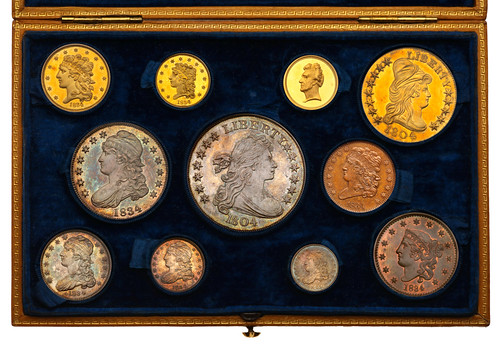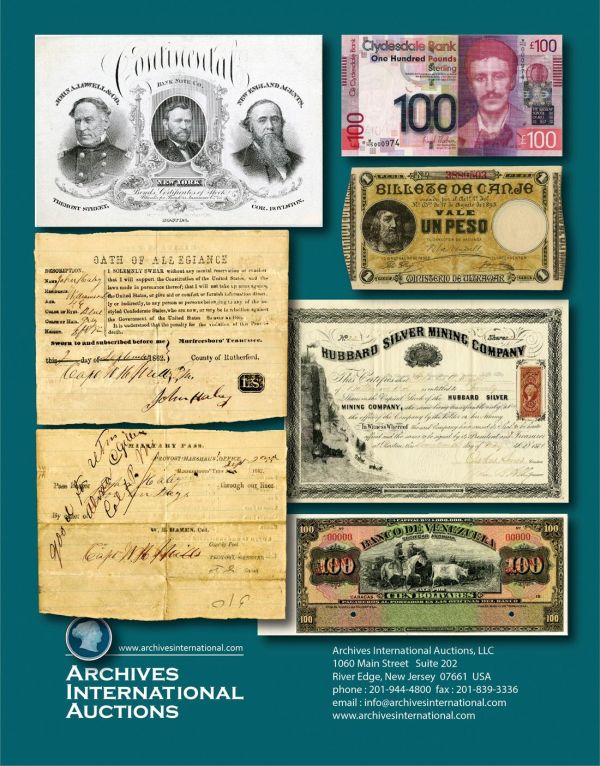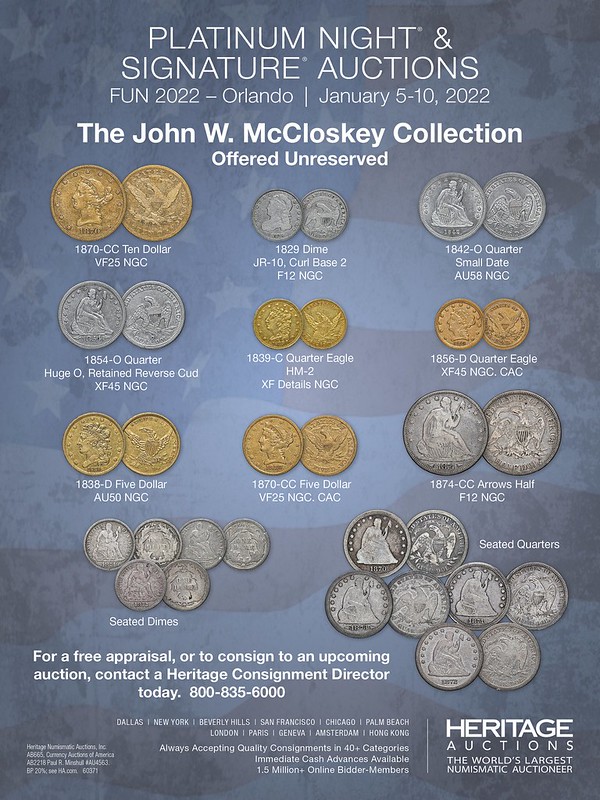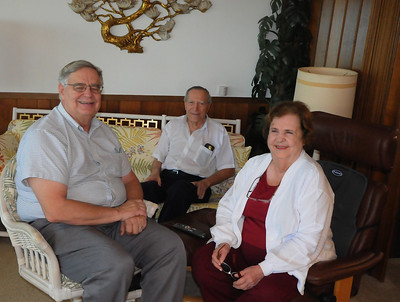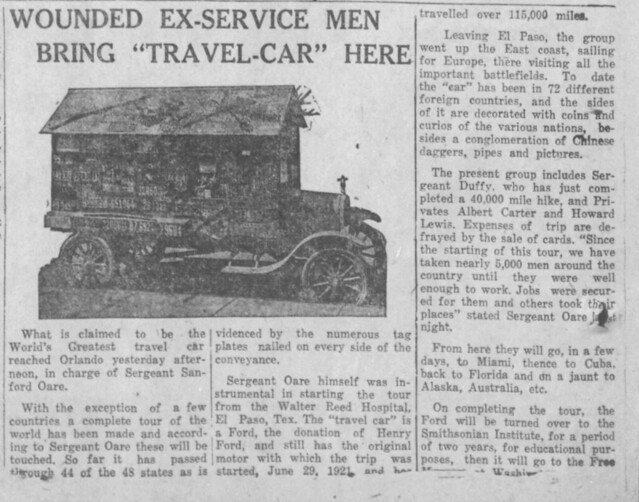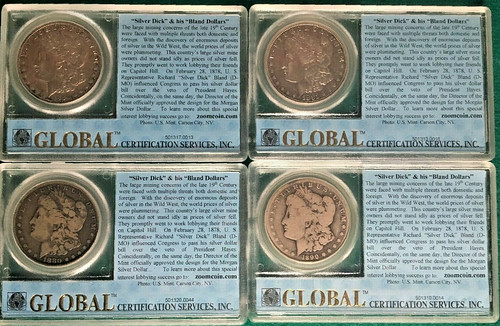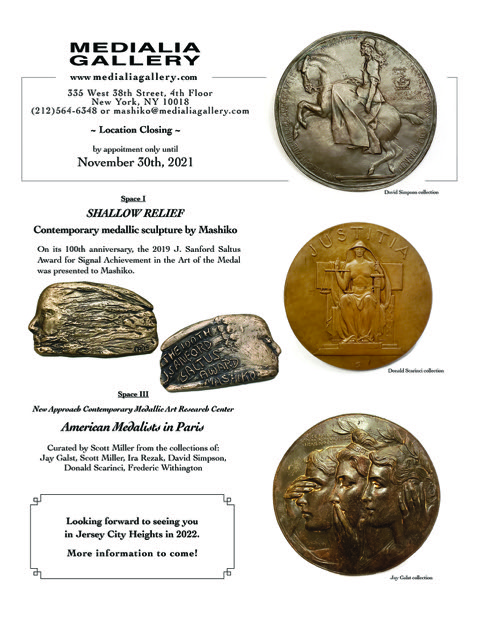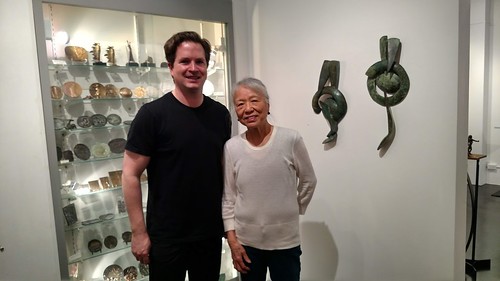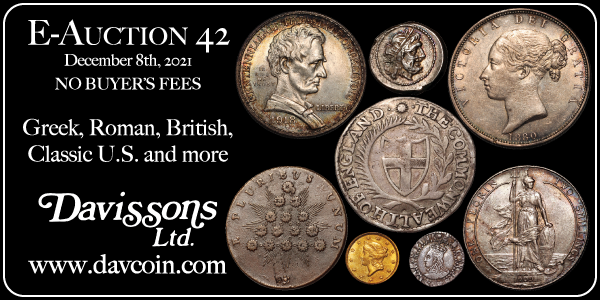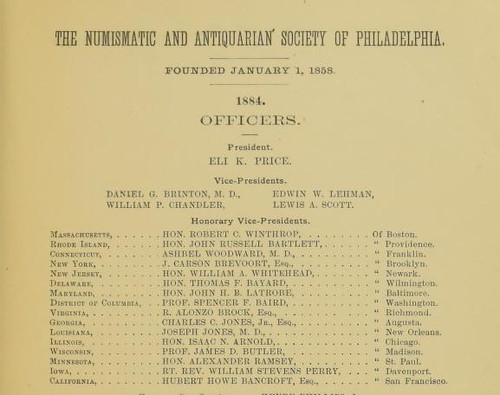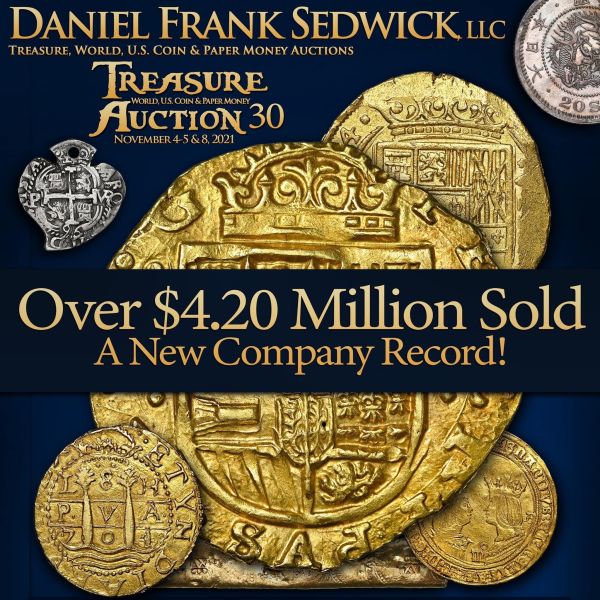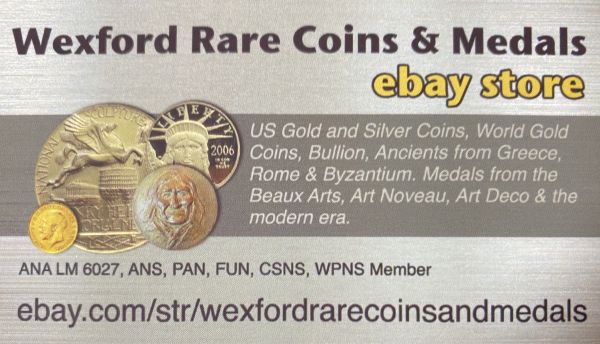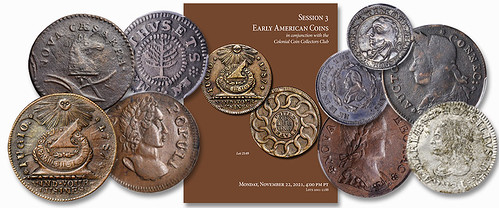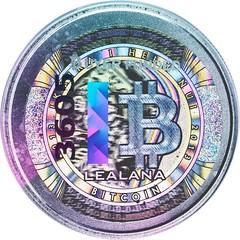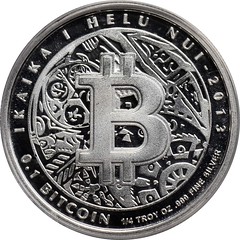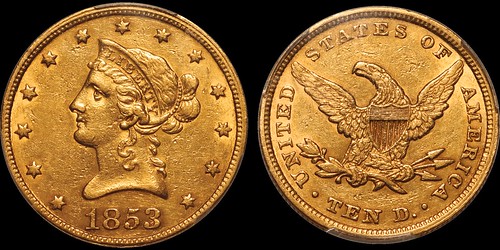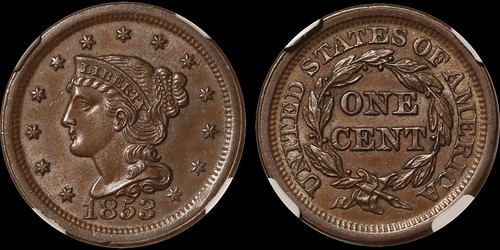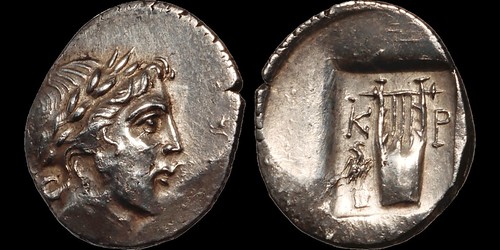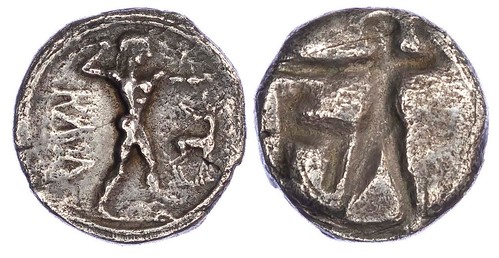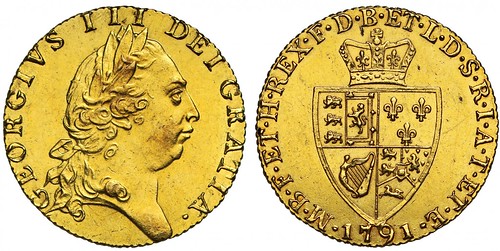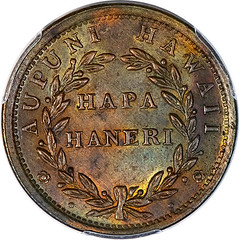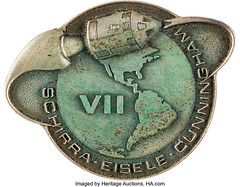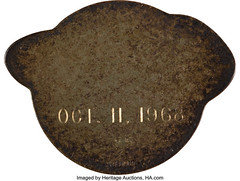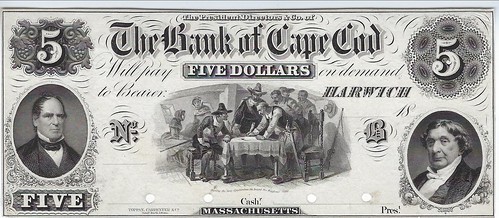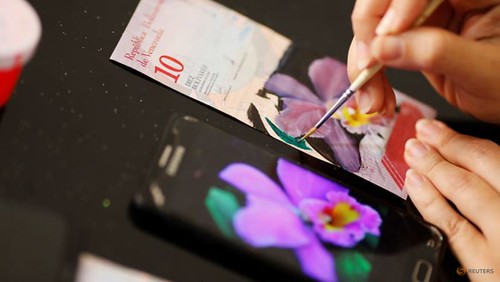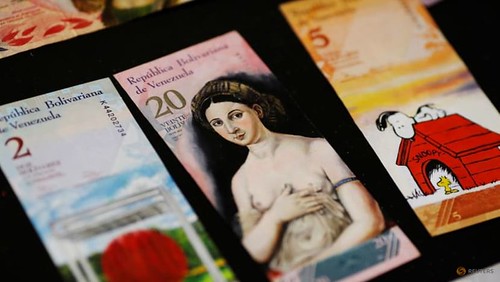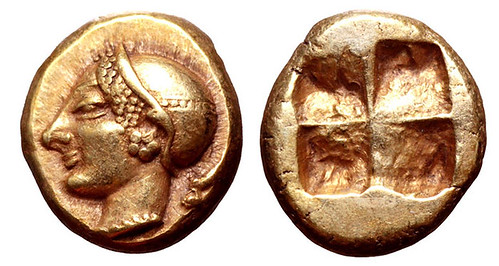
Visit our NBS Sponsors


About UsThe Numismatic Bibliomania Society is a non-profit association devoted to the study and enjoyment of numismatic literature. For more information please see our web site at coinbooks.org SubscriptionsThose wishing to become new E-Sylum subscribers (or wishing to Unsubscribe) can go to the following web page link MembershipThere is a membership application available on the web site Membership Application To join, print the application and return it with your check to the address printed on the application. Print/Digital membership is $40 to addresses in the U.S., and $60 elsewhere. A digital-only membership is available for $25. For those without web access, write to: Charles Heck, Treasurer AsylumFor Asylum mailing address changes and other membership questions, contact Chuck at this email address: treasurer@coinbooks.org SubmissionsTo submit items for publication in The E-Sylum, write to the Editor at this address: whomren@gmail.com BUY THE BOOK BEFORE THE COINSale CalendarWatch here for updates! |
- WAYNE'S WORDS: THE E-SYLUM NOVEMBER 14, 2021
- NEW BOOK: HISTORIA DE LA MONEDA EN PARAGUAY
- NEW BOOK: HISTORICAL MEDAL JOURNAL 2021
- NEW BOOK: GACETA NUMISMáTICA 2021
- BOOK REVIEW: THE TYRANT COLLECTION
- COLLIER PRIZE: ABDY'S ROMAN IMPERIAL COINAGE
- ANS MEMBER CIRCULARS DIGITIZED
- VIDEO: SOUVENIR CARD COLLECTING
- MORE ON THE NAPOLEON MYSTERY MEDALLION
- MORE ON JEAN COHEN'S LINCOLN CENT BOOK
- MORE ON THE TRAVEL CAR COIN MUSEUM
- NOTES FROM E-SYLUM READERS: NOVEMBER 14, 2021
- QUERY: GLOBAL CERTIFICATION SERVICES
- MEDIALIA GALLERY IS MOVING
- VOCABULARY TERM: GALVANISM
- BOYDS BATTERY
- NUMISMATIC SOCIETY OF PHILADELPHIA OFFICERS
- WHITMAN PUBLISHING SEEKS ASSOCIATE EDITOR
- COLONIAL COIN COLLECTORS CLUB 2021 AUCTION
- 2013 SILVER LEALANA 0.1 BITCOIN OFFERED
- DAVISSONS E-AUCTION 42
- NUMISMATIC NUGGETS: NOVEMBER 14, 2021
- CANADA'S OLDEST ENGLISH COIN?
- COMMEMORATIVE COIN TAB TONING
- THANKSGIVING VIGNETTES
- PANDEMIC EFFECTS ON BRICK-AND-MORTAR SELLERS
- VENEZUELAN ARTIST PAINTS OLD BANKNOTES
- GIZMO'S PAINTING ACCEPTS DOGECOIN!
- LOOSE CHANGE: NOVEMBER 14, 2021
- GRANDILOQUENT WORDS OF THE 19TH CENTURY
Click here to read the thin version on the web
Click here to subscribe
Click here to access the complete archive
To comment or submit articles, reply to whomren@gmail.com
Content presented in The E-Sylum is not necessarily researched or independently fact-checked, and views expressed do not necessarily represent those of the Numismatic Bibliomania Society.
WAYNE'S WORDS: THE E-SYLUM NOVEMBER 14, 2021
 New subscribers this week include:
Dr. Pedro Cano, courtesy Roberto Jovel.
Welcome aboard! We now have 6,727 subscribers.
New subscribers this week include:
Dr. Pedro Cano, courtesy Roberto Jovel.
Welcome aboard! We now have 6,727 subscribers.
Thank you for reading The E-Sylum. If you enjoy it, please send me the email addresses of friends you think may enjoy it as well and I'll send them a subscription. Contact me at whomren@gmail.com anytime regarding your subscription, or questions, comments or suggestions about our content.
This week we open with three new books, a review, updates from the ANS and Newman Numismatic Portal, reader comments and more.
Other topics this week include Roman Imperial Coinage, Souvenir Cards, Global Certification Services, Medialia Gallery, Galvanism and Boyd's Battery, the Numismatic and Antiquarian Society of Philadelphia, auction previews, commemorative coin tab toning, the Lealana physical bitcoin, Dogecoin, Thanksgiving vignettes, and grandiloquent words.
To learn more about the numismatics of Paraguay, the Historical Medal Society, the Tyrant Collection, the Napoleon mystery medallion, The Combined Organizations of Numismatic Error Collectors of America, Dealer's Numismatic Association, Whitman Publishing, the Pierre Fricke Collection of Fugio Coppers, the "Comitia Americana" tray, the oldest English coin found in Canada, and the Archaic Smile on ancient coins, read on. Have a great week, everyone!
Wayne Homren
Editor, The E-Sylum
NEW BOOK: HISTORIA DE LA MONEDA EN PARAGUAY
Here's the announcement of a new book on the numismatics of Paraguay by Raúl Olazar. Congratulations! -Editor
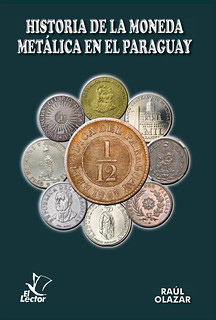 The study of the historical evolution of events, phenomena or objects worldwide
has always been interesting. Getting to know the history and origin of items will
always be of importance for any society. This is how Raúl's new book was born, a
research material entitled HISTORIA DE LA MONEDA METÁLICA EN
PARAGUAY, in collaboration with Editorial El Lector.
The study of the historical evolution of events, phenomena or objects worldwide
has always been interesting. Getting to know the history and origin of items will
always be of importance for any society. This is how Raúl's new book was born, a
research material entitled HISTORIA DE LA MONEDA METÁLICA EN
PARAGUAY, in collaboration with Editorial El Lector.
Currency is part of the heritage of people and has represented over time; the ideal way to exchange goods and services, although this process has not always worked in the same manner. Currency marked a shift in the dynamics of markets and thanks to them several activities in this area were simplified.
Numismatics is a discipline that starts from archeology and that is responsible for studying the coins that are issued in a nation or country. It also refers to the act of collecting coins, even though they are not interdependent activities.
This book chronologically presents the history of our coins (PARAGUAY), from the time of barter through its various periods and changes until it became what it is today, one of the most stable coins in the region.
This book is dedicated to the memory of Don Miguel A. Pratt Mayans and Don Vir Heriberto Alonso, two individuals who always gave me words of support to continue with this passion and who unfortunately left us during the period of development of this book.
HISTORY OF THE METALLIC CURRENCY IN PARAGUAY, a book of almost 200 pages that chronologically presents the monetary history of our country, from its beginnings and going through its periods in detail.
The book has a cost of USD 20 and can be purchased with the author by sending an email to olazarraul@gmail.com
Raúl notes that the shipping cost is separate and normally around 10-15 USD. -Editor

NEW BOOK: HISTORICAL MEDAL JOURNAL 2021
Andrew Wager of the Historical Medal Society passed along this information about the group's new journal and website. Thank you! -Editor
The Historical Medal Society
 After a successful Congress held in July at the M40 J15 Warwick Hotel the Historical Medal Society has just now launched its own website. It can be found at
https://www.historicalmedalsociety.org.uk/
After a successful Congress held in July at the M40 J15 Warwick Hotel the Historical Medal Society has just now launched its own website. It can be found at
https://www.historicalmedalsociety.org.uk/
Collectors of all types of historical medals and medallions should find much to interest them on this site as it develops over the course of the next year. It is intended that more material links and articles of interest will be added in the next few months. The society has also published Volume 3 of its Historical Medal Journal a 64-page magazine containing a host of articles on all types of medal from Roman to the present day.
The HMJ is now gaining an international reputation with subscribers in Europe America and New Zealand as well the UK. Anyone with an interest in this fascinating field of collecting should consider subscribing. For further details see the website or contact the society at historicalmedalsociety@gmail.com
NEW BOOK: GACETA NUMISMáTICA 2021
Adrián González-Salinas of Monterrey, Nuevo León, México submitted this announcement of a new book by the Numismatic Society of Monterrey. Thank you! -Editor
Monterrey's Numismatic Society (Mexico) has published the Gaceta Numismática (Numismatic Gazette) in its web page (https://sonumty.org.mx/) and it's free to be downloaded.
The published articles related to Mexican numismatics are:
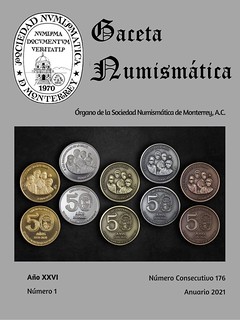
- 50th Anniversary Medal of Monterrey Numismatic Society (1970-2020)
- Coinage Shortage Notes during Mexican Colonial Period
- "The Hunter" Shipwreck
- Approach to "JML" Insurgent Counterstamp of Gen. José María Liceaga (1780.1818)
- Brief Overview of What Happened 200 years ago (War of Independence, 1821)
- The Enigmatic Oaxaca Mint and its Varieties on Republic 8 Reales Coins
- The Fantastic Hacienda Token of Tocuila in Mexico
- Identification of RevMex's Suriana $2 Coins in Doubtful Pieces
- Ethical Guidelines in Numismatics
- Brief Chronicle of "Numismatists' Nights" During Covid Pandemic
Total pages: 162
Language: Spanish
Each article has an abstract in Spanish and English.
Many of the authors are E-Sylum readers.
The Gaceta Numismática can be download directly from this link: https://drive.google.com/file/d/1VcgNJrzQye8-vu5woLkMTXt0HwIHrcSt/view
Also, Monterrey's Numismatic Society has planned to print 100 B&W and 11 Full-Color copies of this issue.
THE BOOK BAZARRE
BOOK REVIEW: THE TYRANT COLLECTION
In the November 2021 issue of The Mint Master from the Utah Numismatic Society, Doug Nyholm published a review of the printed catalogs of The Tyrant Collection. With permission, we're republishing it here. -Editor
I recently acquired two booklets published by the owners of the Tyrant Collection, one on US. Type coins which was recently displayed at the recent ANA Convention, and the other on U.S. Gold Eagles minted from 1795 to 1933. Each coin is pictured with a brief description but what is absolutely astounding is the condition of each coin. The vast majority are of the finest known or nearly the finest known with most coins, even 18th and 19th century examples in MS or Proof 67 or 68. The US type set booklet depicts 420 different coins while the US Gold Eagle book has 319 different Eagles displayed.
There are a total of 7 different books with the other 5 being composed of Foreign Tyrants entitled: Tyrants of the Seine / Tyrants of the Tiber / Tyrants of the Tyrrhenisn & Adriatic Seas / Tyrants of the Tigris & Euphrates / and Tyrants of the Thames. Many of the actual coins have been displayed at various events. The goal of the collection is to construct the finest coins of the world with the emphasis on every Tyrant who ruled every major territory or country, preferably a large gold coin depicting the rulers portrait or effigy and name in the finest possible condition.
Each of the 7 booklets can be ordered for only $10 each, printed softcover on glossy paper with exceptional photo quality. They are available from www.thetyrantcollection.com. You can also view the coins also at their website.
I recently ordered a couple copies and they arrived swiftly. They are inexpensive and very nicely done - well worth the cost. The exhibit of the U.S. coins at the ANA World's Fair of Money was magnificent - everything about this collection is first class, and that goes for the catalogs, too. -Editor
For more information, or to order, see:
http://thetyrantcollection.com/shop/
See also:
King of Siam Set
(http://thetyrantcollection.com/the-king-of-siam-set/)
To read the earlier E-Sylum article, see:
TYRANT COLLECTION U.S. TYPE COIN ANA EXHIBIT
(https://www.coinbooks.org/v24/esylum_v24n23a07.html)
COLLIER PRIZE: ABDY'S ROMAN IMPERIAL COINAGE
Richard Abdy's 2020 book Roman Imperial Coinage (RIC) vol.II.3 has won the American Numismatic Society's 2021 Collier Prize. Here's the press release. -Editor
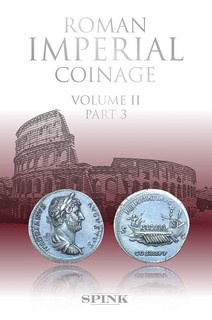 Winner of the ANS's Collier Prize Announced
Winner of the ANS's Collier Prize Announced
In 2020, Carole Anne Menzi Collier established the Collier Prize in Ancient Numismatics at the American Numismatic Society, a new award offered for the first time in 2021. The Prize is named after her late husband Professor James M. Collier and commemorates the life of a remarkable man, an ardent lover of the history and culture of Europe and the Ancient world, and a passionate collector of ancient Greek and Roman coins. A feature on the life of Prof. Collier was published in ANS Magazine 2020, vol. 4.
This substantial monetary prize is to be awarded every third year to the best single or multi-authored book, catalogue, or online digital work in the field of ancient numismatics (650 BCE to 300 CE). The winner(s) receive prize money of $20,000, to be split equally in the event of a multi-authored work. For the initial prize, eligible publications were limited to those works published in 2019 or 2020. A jury of five senior numismatists appointed by the President of the ANS reviewed the nine works submitted this year for the contest and, after a protracted period of study and discussion, selected the winner of the 2021 Collier Prize.
At the Annual Meeting held on October 23rd, the winner was announced: Richard Abdy's Roman Imperial Coinage (RIC) vol.II.3 on the coinage of the Emperor Hadrian from AD 117 to 138 (Spink, 2020). Abdy has worked at the British Museum since 1993 and since 1998 has been a curator of Roman coins in the Department of Coins and Medals. Aside from his award-winning RIC volume, Abdy has published widely on Roman coinage and has long been involved in recording Roman coin hoards in England. An award ceremony for Abdy will be announced in the coming months.
We are certainly thrilled to bestow the first Collier Prize on Abdy's exceptional study of Hadrian's coinage,
ANS Executive Director Gilles Bransbourg said, and at the same time extend our gratitude to Carole Anne Menzi Collier for establishing what will no doubt become one of the most important Prizes in our field.
To read the earlier E-Sylum article, see:
ANS COLLIER PRIZE IN ANCIENT NUMISMATICS
(https://www.coinbooks.org/v23/esylum_v23n49a06.html)
To read the complete article, see:
Richard Abdy's Roman Imperial Coinage
Wins the Collier Prize
(http://numismatics.org/press-release-2021-collier-prize-announced/)
ANS MEMBER CIRCULARS DIGITIZED
The latest addition to the Newman Numismatic Portal is a collection of American Numismatic Society member biography questionnaires. Project Coordinator Len Augsburger provided the following report. -Editor
American Numismatic Society Member Circulars Digitized
Scanning of ANS library and archival materials, sponsored by Newman Portal, continues at a brisk pace. Recently scanned were a set of about a hundred ANS member questionnaires, c. 1890. These circulars include rich biographical information and will be useful to students of ANS and numismatic history.
The entry for Emmanuel J. Attinelli will be of special interest to bibliophiles, as he wrote the first substantive bibliography of American numismatic literature, Numisgraphics, in 1875. Attinelli, a physician, was clearly proud of his American-Italian heritage and Old World noble roots. The document is signed by Attinelli's wife, who wonders if the Society might take some relics off her hands, said to have originated from catacombs in Italy.
Link to Attinelli member questionnaire on Internet Archive:
https://archive.org/details/attinelliemmanue00amer/mode/1up
Link to ANS member surveys on Newman Portal:
https://nnp.wustl.edu/library/archivedetail/515008

VIDEO: SOUVENIR CARD COLLECTING
These are selections from the David Lisot Video Library that feature news and personalities from the world of coin collecting. David has been attending coin conventions since 1972 and began videotaping in 1985. The Newman Numismatic Portal now lists all David's videos on their website at:
https://nnp.wustl.edu/library/multimediadetail/522852
Here's one on Souvenir Card Collecting. -Editor
Souvenir Card Collecting Offers Rare Banknote Engravings at Affordable Prices.
VIDEO: 6:49.
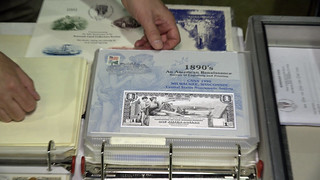 Greg Alexander, Vice-President, Souvenir Card Collectors Society,
www.souvenircards.org.
Greg Alexander, Vice-President, Souvenir Card Collectors Society,
www.souvenircards.org.
David Lisot, Interviewer,
CoinTelevision.com. August 10-14, 2021.
Souvenir cards typically are mementos or souvenirs of a particular occasion, exposition, or hobbyist show. They are not postally valid or intended for use as postcards. Most are printed on high quality card stock using intaglio methods (steel plate engravings). Since 1981, the Souvenir Card Collectors Society has worked to promote this hobby and help collectors understand and catalog the many types of souvenir cards in existence. More than 1,000 varieties of intaglio souvenir cards have been issued since 1960 and hundreds more non-intaglio varieties. The Society maintains an ongoing numbering system as new cards are issued.
An excerpt of the video is available for viewing on the Coin Television YouTube Channel at:
https://youtu.be/5H5lNJP2LkI

MORE ON THE NAPOLEON MYSTERY MEDALLION
Pete Smith submitted these new thoughts on the previously-discussed mystery medallion. Thanks! -Editor
The July 4, 2021, issue of The E-Sylum had a mystery medal with a rider on a horse. Chip
Howell saw a similarity to the painting of Washington Crossing the Alps.
I thought the
differences were significant.
Napoleon Crossing the Alps
is an iconic painting by Jacques-Louis David executed in 1801.
It is also known as Napoleon at the Saint-Bernard Pass.
There are actually five versions of the
painting that hang in different museums.
On Saturday, November 13, 2021, I participated in a Zoom meeting for Medal Collectors of
America. Stephen Scher showed a medal by Bertrand Andrieu of Passage of the Saint-Bernard
Pass,
executed in 1800, before the David painting. This also has similarities to the mystery
medal.
I took a closer look at an enlargement of the mystery medal. What I initially thought was an unusual cap, I now believe was intended to represent Napoleon's hat. The medal is not based on the David painting but rather on various similar images of Napoleon from that era.
With the crude execution and lack of any inscription, I still believe it is a decorative piece with little value.
To read the earlier E-Sylum articles, see:
NOTES FROM E-SYLUM READERS: JULY 4, 2021 : Identification of Colonial Medal?
(https://www.coinbooks.org/v24/esylum_v24n27a12.html)
NOTES FROM E-SYLUM READERS: JULY 11, 2021 : Mystery Medallion: Napoleon Legion of Honour Eagle?
(https://www.coinbooks.org/v24/esylum_v24n28a08.html)
MORE ON JEAN COHEN'S LINCOLN CENT BOOK
Regarding Jean Cohen's Lincoln Cent variety book, Mark Lighterman submitted these notes on the book's acquisition by The Combined Organizations of Numismatic Error Collectors of America (CONECA). Thank you. -Editor
I first had the pleasure of meeting Jean Cohen in early 2013. Jean contacted me as president of CONECA to work out the details of donating her book ‘The Classification and Value of Errors on the Lincoln Cent' to CONECA.
Jean's original email to me stated the following:
"Forty-three years ago I published "The Classification and Value of Errors on the Lincoln Cent", 600 pages, 6000 illustrations. Life took me down another path shortly thereafter. Now I am 82 years old with macular degeneration. The time has come for me to get all this material into the hands of those that will appreciate it."
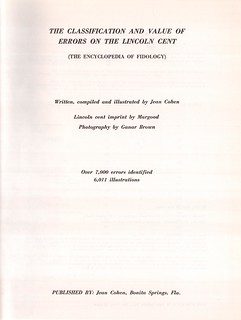 Both sides wanted to meet so we could work out the details of the
donation. Jean, Gary Lewis, her husband Don, my mother and myself meet
at her home in Bonita Springs and as we began to talk about errors and
our love for the hobby and CONECA she realized the donation would in
fact be in good hands and by the end of the meeting she had donated all
copyrights to the book, her compete collection of Lincoln cents that
were the reference coins to those listed in the book and an additional
$500.
Both sides wanted to meet so we could work out the details of the
donation. Jean, Gary Lewis, her husband Don, my mother and myself meet
at her home in Bonita Springs and as we began to talk about errors and
our love for the hobby and CONECA she realized the donation would in
fact be in good hands and by the end of the meeting she had donated all
copyrights to the book, her compete collection of Lincoln cents that
were the reference coins to those listed in the book and an additional
$500.
As the steward of the collection for CONECA, very few have had any access to the coins because of the cataloging method she used in storing the collection and even after all these years working out whom and how to proceed with any changes the collection is still intact as it originally donated. Below is a photo that I took of Jean, Don and Gary Lewis at the end of that meeting. (Gary Lewis left, Don Cohen center, Jean Cohen right)
CONECA also has been discussing details of how to re-publish the book for our members. Out of all the materials she donated was the original paste-up and one unbound copy of the book. She did not even retain a bound copy for herself.
We did keep in touch occasionally throughout the years until her passing. On a side note and what I still feel sealed the deal that day was during our meeting (Jean, Gary and myself), Myrna and Don went out onto the porch of their home that overlooks the Gulf to talk and connect. It was a surprise for them to interrupt our meeting to find out that my mother worked alongside Don's brother at the University of Miami Medical school some fifty years earlier. Our hobby is a very small community.
To read the earlier E-Sylum article, see:
JEAN COHEN'S LINCOLN CENT BOOK
(https://www.coinbooks.org/v24/esylum_v24n45a12.html)
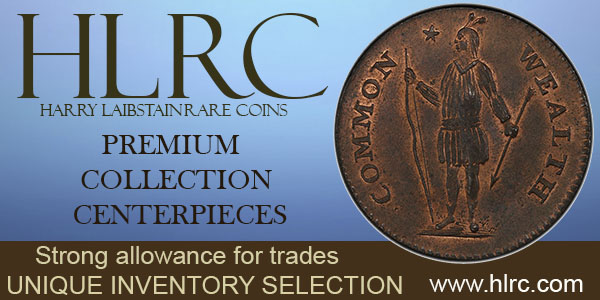
MORE ON THE TRAVEL CAR COIN MUSEUM
Dave Lange writes:
"I liked the postcard with its traveling museum. The date range for this vehicle (and the card) may be narrowed down considerably from the 1900-20 provided. The former is an example of the ubiquitous Ford Model T. It has a nickel-plated radiator rather than the earlier brass variety, so the truck is a 1916 model or later. The font used in the card's title was in vogue from roughly 1910-25. Given that the vehicle had already logged over 100 thousand miles, I suggest that the postcard probably dates to the period 1918-25."
Great observations. Thanks! I cropped the postcard image to just contain the vehicle and tried a Google image search hoping to discover a web page or newspaper article, but came up empty. But with Dave's year range I went back to Newspapers.com and tried again - bingo!! Among the first hits was a December 15, 1924 article in The Orlando Sentinel. -Editor
The "World's Greatest Travel Car" carried wounded ex-servicemen around the U.S. and the world. "To date the "car" has been in 72 different foreign countries, and the sides of it are covered with coins and curios of the various nations..." The vehicle is indeed a Ford, donated by Henry Ford himself. The article notes that on completing the tour the Ford would be displayed at the Smithsonian for two years before going to the Free Museum at Washington, apparently as a memorial to the disabled vets of WWI.
So - where is/was the Free Museum at Washington? The words in the name are common and Google was no help. Wikipedia doesn't have a page for it. And where is the Travel Car today? Does it still exist? -Editor
To read the complete newspaper article, see:
https://www.newspapers.com/clip/88597608/sergeant-sanford-oare-travel-car/
To read the earlier E-Sylum article, see:
The Travel Car Coin Museum
(https://www.coinbooks.org/v24/esylum_v24n45a13.html)

NOTES FROM E-SYLUM READERS: NOVEMBER 14, 2021
Numismatics Knows No Borders
Regarding last week's addition of a subscriber from Inner Mongolia,
Andy Newman writes:
"Wow, impressive diversity, Wayne."
Indeed. While we've had international subscribers since our very early issues, it's amazing to see our wide and growing reach. Numismatics knows no borders! -Editor
Dealer's Numismatic Association
Regarding U.S. coin dealer organizations,
George Cuhaj writes:
 "In the 1976-1979 era there was a group out of Eastern PA called the Dealer's Numismatic Association.
"In the 1976-1979 era there was a group out of Eastern PA called the Dealer's Numismatic Association.
"They did a Friday-Sunday show in mid-October. The 1977 show was in King of Prussia / Valley Forge area, the 1979 show was at the gym of Towson University in Towson, MD (just outside of Baltimore) (It was also the location of several spring MD State shows). I won the Junior Best in show exhibit award at the first, and the adult Best in Show award at the latter.
"I do not know where the 1978 show was held but it may have been at Lanham, MD at the hotel with the underground (garage) space exhibition area near the old Capitol Beltway station.
"It was an early transition from club sponsored "volunteer staff" show organization, towards "professional" staffed shows. I do not think there was a fourth show."
Thanks! I wasn't aware of that one. -Editor
To read the earlier E-Sylum article, see:
U.S. COIN DEALER ORGANIZATIONS
(https://www.coinbooks.org/v24/esylum_v24n45a19.html)
Parnell Nelson Ancient Coins Cartoons
Bill Daehn writes:
"In the November 7 E-Sylum you highlighted the newly published compilation of Claire Franklin's numismatic cartoons which have appeared on the CoinsWeekly site. Her cartoons usually focus on ancient coins. It may be worth mentioning that another delightful cartoon which focused on ancient coins was done by Parnell Nelson. His cartoons appeared in The Celator, the monthly magazine dedicated to ancient coins, from 1990 until the publication's demise in 2012."
To read the earlier E-Sylum article, see:
NEW BOOK: FRANKLIN'S WORLD CARTOONS
(https://www.coinbooks.org/v24/esylum_v24n45a04.html)
More on Spending Legal Tender Coins
Tom DeLorey writes:
"Apropos the gentleman in England who was arrested for trying to spend a 100 Pound commemorative coin on petrol, I am reminded of a situation back in the 1970's wherein a certain numismatic firm that did a lot of business in new issues was selling Legal Tender gold coins from an assortment of Caribbean and Central America countries with the sales pitch that the coins were legal tender and could always be redeemed at their full face value in the country of issue. I believe that the Panamanian 100 Balboas was still worth $100 U.S., the Bahamas Dollar-denominated coins were still equal to a U.S. dollar, and everything else had some significant "face value."
"Then a certain numismatic writer with a popular newsletter showed up at the central bank of Panama with 10,000 Balboas in Panamanian gold coins and requested $10,000 U.S. He was refused. He then went to several other central banks in other countries and attempted to make similar exchanges. He was refused every time, even though the original advertising had never mentioned any limits on exchanges. He was never threatened with arrest, he was just turned away.
"When he got home he wrote a scathing report about what a crock these "Legal Tender" gold coins were, and the market for them disappeared. Then the Hunt Brothers hysteria drove the melt values of these coins fare above their alleged "face values," and many of them disappeared into the melting pot."
Thanks! Great to have someone around to call b*llsh*t on such claims. -Editor
To read the earlier E-Sylum article, see:
NOTES FROM E-SYLUM READERS: NOVEMBER 7, 2021 : Commemorative Legal Tender Coins Spent in the U.S.?
(https://www.coinbooks.org/v24/esylum_v24n45a13.html)
Sedwick Auction 30 Price Record
Price records continue to be broken again and again in this numismatic bull market. -Editor
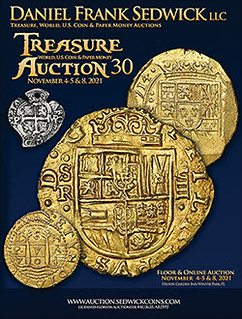 Augi Garcia of Daniel Frank Sedwick, LLC writes:
Augi Garcia of Daniel Frank Sedwick, LLC writes:
"We're pleased to announce that this Treasure Auction 30 realized over $4.20 million and virtually almost all lots sold! This is a new record sale for our company and the third consecutive time this record has been broken. This is ultimately a testament both to our consignors who entrust us to catalog and sell their rarities for top value as well as our bidders who are seeking to build their collections. We are thankful for both and are already looking forward to our Treasure Auction 31 in Spring of 2022!""
The cover coin, lot 1252 (the finest known 1644 Philip IV gold cob 8 escudos) realized $60,000. -Editor
To view the prices realized, see:
https://auction.sedwickcoins.com/Treasure-World-U-S-Coin-Paper-Money-Auction-30_as75600
https://www.sedwickcoins.com/pricesrealized/t30prices.pdf
To read the earlier E-Sylum article, see:
SEDWICK TREASURE AUCTION 30 ANNOUNCED
(https://www.coinbooks.org/v24/esylum_v24n41a19.html)
Library Jokes
Last week I opened with a library joke. -Editor
 Steve Shupe of Los Gatos CA writes:
Steve Shupe of Los Gatos CA writes:
"Love your comment about Pavlov's dog and Schrodinger's Cat! Too Funny!"
Ken Berger writes:
"Aha! A Physics joke - Not Bad!"
Pete Smith writes:
"Not original. But still funny."
Pete's correct on both counts - I saw it on a bulletin board type system at the office, and couldn't resist sharing it:
"I went to the library to see if could check out a book on Pavlov's dogs and Schrodinger's cat. The librarian said that it rang a bell but she wasn't sure if they had it or not."
I work with lots of nerds. There are many more library jokes out there. Here are a couple that caught my fancy.
"You scream in a Library and everyone looks at you funny.
But you scream in an airplane and everyone joins in."
"A man walks into a library and asks the librarian for books about paranoia.
She whispers, "They're right behind you!"
-Editor
For more library jokes, see (at one's own risk, of course):
https://upjoke.com/library-jokes
To read the earlier E-Sylum article, see:
WAYNE'S WORDS: THE E-SYLUM NOVEMBER 7, 2021
(https://www.coinbooks.org/v24/esylum_v24n45a01.html)

QUERY: GLOBAL CERTIFICATION SERVICES
British tabloid The Sun has recently taken to republishing eBay sale results as articles with clickbait headlines - "Rare Lincoln Penny Sells for $thousands - do you have one?" It's not a bad way to get attention online, and probably something actual numismatic organizations should consider doing, only with better facts and links to appropriate related websites, as a way to reach out to potential collectors.
Anyway, one of these articles caught my eye this week because of the holders the coins were in: "Global Certification Services". I don't believe we've discussed this company before - is anyone familiar with them? A search on the Newman Portal turned up hits on Coin World circa 2002 and in both CW and The Numismatist circa 2006-2007. From the snippet text these seem to be paid ads. Len Augsburger of NNP supplied an image of an ad from the Coin World issue of 8/12/2002.
The holders include some informative text and images. The eBay lot discussed was a group of 13 circulated Carson City dollars in GCS holders. There are no grades listed. -Editor
RARE coins can sell online for a pretty penny, especially full collections.
A set of 13 Morgan Silver Dollar coins sold for more than $3,000 earlier this month.
This set of Carson City Morgan Silver Dollar coins dates back to between 1878 and 1893, according to the seller.
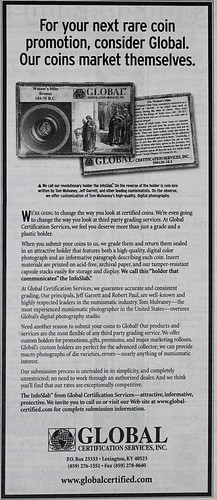
Can anyone tell us more about this outfit? Who were the owners? -Editor
To read the complete article, see:
COINING IT Rare set of dollar coins sells for $3,045 – do you have one of the pieces in your collection?
(https://www.the-sun.com/money/4049491/morgan-dollar-coins-sells-3045-rare-collection/)
It's questionable how newsworthy this is. It's a dodgy listing that appears to have been relisted by the same seller. "I AM NOT A COIN COLLECTOR AND NO NOTHING ABOUT GRADES SO YOU WILL HAVE TO LOOK CLOSELY AT THE PHOTOS" -Editor
To view the eBay listings, see:
COMPLETE CARSON CITY MORGAN SILVER DOLLAR SET ALL DATES 13 COINS
(https://www.ebay.com/itm/224662198419)
COMPLETE CARSON CITY MORGAN SILVER DOLLAR SET ALL DATES 13 COINS
(https://www.ebay.com/itm/224678394107)

MEDIALIA GALLERY IS MOVING
Medialia Gallery is moving from its longtime New York location. Mashiko forwarded this announcement flyer. Open by appointment through the end of this month, the art medal gallery plans to reopen across the river in Jersey City Heights in 2022. Stay tuned for more details. -Editor
Steve Roach and I visited the gallery in 2019 - see the linked articles for more, and stay tuned for information on the reopening. -Editor
For more information, see:
http://www.medialiagallery.com/
To read earlier E-Sylum articles, see:
(https://www.coinbooks.org/v22/esylum_v22n16a25.html)
MEDIALIA GALLERY VISIT
(https://www.coinbooks.org/v22/esylum_v22n16a26.html)
MEDIALIA EXHIBITS MASHIKO'S MEDALLIC SCULPTURE
(https://www.coinbooks.org/v23/esylum_v23n07a27.html)
VOCABULARY TERM: GALVANISM
Here's another entry from Dick Johnson's Encyclopedia of Coin and Medal Terminology. I added an image of a Boyds Battery. -Editor
Galvanism. The branch of physical science dealing with electrical currents. It is named after Luigi (or Aloisio) Galvani (1737-1798), an Italian who is credited with its first observation (1791). Shortly after Galvani's discovery it was another Italian, Alessandro Volta (1745-1827) who developed the voltaic pile (1800) that lead to the primitive battery which supplied the current necessary for electrolysis.
The application of galvanism to coins and medals is in electroforming and electroplating. Pattern making is possible by electrogalvanism in such fidelity that oversize patterns can be used on the die-engraving pantograph to cut dies and hubs in fine detail for coins and medals. The term for these electroformed patterns is called galvano, a term named directly after Luigi Galvani.
 Galvanism was set back with the rise of "electrotherapeutics" – the use of small electric currents in treatment of human ails. A galvanic cell was placed next to the skin of an affected person. An example was the Boyd's Battery Medal illustrated. It was of no benefit or healing whatsoever, but even the Encyclopedia Britiannica treated the subject with great reverence even into the 20th century.
Galvanism was set back with the rise of "electrotherapeutics" – the use of small electric currents in treatment of human ails. A galvanic cell was placed next to the skin of an affected person. An example was the Boyd's Battery Medal illustrated. It was of no benefit or healing whatsoever, but even the Encyclopedia Britiannica treated the subject with great reverence even into the 20th century.
Galvanos are metal shells which replicate a bas-relief design. They are made in an electrolytic tank usually of pure copper but can be any metal which conducts electricity. They are ideal to serve in the negative as the patterns for dies, from oversize to cut a die in any size. Galvanos were an important step for the production of all coins and art medals by all mints in the last half of the 20th century, being gradually replaced by epoxy molds by 2010. They also make spectacular wall plaques in positive form.
To read the complete entry on the Newman Numismatic Portal, see:
Galvanism
(https://nnp.wustl.edu/library/dictionarydetail/515976)

BOYDS BATTERY
While searching for an image of the Boyd's Battery medal for the Vocabulary article in this issue, I came across this Wordcraft page on Magnetic Healing Batteries. -Editor
The most famous of the medical batteries was the Boyds Battery. They are fairly easy to find and they polish up nicely. They were made with different metals that promised to create a healing electrical current when pressed against your skin. The galvanic properties were released by the different metals reacting to the moisture in your skin. Some people claimed that they tingled as they worked to draw out the bad energies from your body and replace them with good energy.
 Boyds Battery came out in 1878 and was "improved" in 1879. He writes in his book "Boyds Battery", that two of his employees stole his idea and created the Sagendorph Battery which was a direct knockoff of Boyd's design. Boyd claimed that their battery was just a combination of metals that did not do anything as opposed to his battery that was a combination of metals that did cure ills.
Boyds Battery came out in 1878 and was "improved" in 1879. He writes in his book "Boyds Battery", that two of his employees stole his idea and created the Sagendorph Battery which was a direct knockoff of Boyd's design. Boyd claimed that their battery was just a combination of metals that did not do anything as opposed to his battery that was a combination of metals that did cure ills.
Whatever the truth, others followed and produced their own batteries - Richardson and Downing were two that I have found. There were also magnetic belts, shoe inserts, and other products that used either magnetism or batteries to provide some relief to your ills.
The article illustrates several competing products. These were meant to be worn on a necklace against the skin. -Editor
To read the complete article, see:
Magnetic Healing Batteries
Quack Medical Device or a True Cure?
(http://www.wordcraft.net/magneticbattery.html)
NUMISMATIC SOCIETY OF PHILADELPHIA OFFICERS
American Numismatic Biographies author Pete Smith submitted this article on Honorary Vice Presidents of the Numismatic and Antiquarian Society of Philadelphia. Thanks. -Editor
The Numismatic Society of Philadelphia was formed on January 1, 1858, as the first coin club in the United States. Joseph A. Mickley served as first president. In 1865, the name was changed to the Numismatic and Antiquarian Society of Philadelphia. The Society was reported to remain active as recently as 2012.
While doing research this week, I came across a list of Honorary Vice Presidents for the Numismatic and Antiquarian Society of Philadelphia in 1884. I noted the name of Alexander Ramsey. Last year I moved from Minneapolis into Ramsey County. While Ramsey was governor of Minnesota in 1862, annuity payments were withheld from Indians on the Dakota Reservation, leading to the U. S. Dakota War of 1862. My home town of New Ulm, Minnesota, was attacked, burned and temporarily abandoned. Fortunately, I was not hurt in the attacks.
So, who were the honorary vice presidents?
Massachusetts HON. ROBERT C. WINTHROP (1809-1894)
Attorney. Former Senator, Representative and Speaker of the U. S. House of Representatives. President of the Massachusetts Historical Society 1855-1885. Great-great grandfather of John Kerry.
Rhode Island HON. JOHN RUSSELL BARTLETT (1805-1886)
Bookseller and publisher. Former Secretary of State in Rhode Island. Member of the Rhode Island Historical Society, the New England Historic Genealogical Society and the American Antiquarian Society.
Connecticut ASHBEL WOODWARD M.D. (1804-1885)
Physician and Civil War battlefield surgeon living in Franklin, Connecticut, and local historian. His home became the Ashbel Woodward Museum.
New York J. CARSON BREVOORT, Esq, (1818-1887)
President of the Long Island Historical Society and member of several other historical societies. Coin collector and book collector.
New Jersey HON WILLIAM A. WHITEHEAD (1810-1884)
Historian and writer, author of books on New Jersey history.
Delaware HON. THOMAS F. BAYARD (1822-1898)
Attorney. Senator from Delaware 1869-1885, later U. S. Secretary of State 1885-1889. He was a hard money advocate.
Maryland HON. JOHN H. B. LATROBE (1803-1891)
Attorney. He invented the Latrobe stove. President of American Colonization Society 1853- 1891. President of the Maryland Historical Society.
District of Columbia PROF. SPENCER F. BAIRD (1823-1887)
Ornithologist, Ichthyologist and herpetologist. In 1878 he replaced Joseph Henry to become the second Secretary of the Smithsonian Institution.
Virginia R. ALONZO BROCK, Esq. (1839-1914)
Civil War veteran employed in the lumber business. Antiquarian and historian. Corresponding Secretary of the Virginia Historical Society and Secretary of the Southern Historical Society.
Georgia CHARLES C. JONES, Jr. Esq. (1831-1893)
Attorney. Member of the American Antiquarian Society and member of the American Philosophical Society; Author of books on Georgia History. His autograph collection included the hand written will of Button Gwinnett.
Louisiana JOSEPH JONES, M. D. (1833-1896)
Physician. President of the Louisiana Board of Health 1880-1884; Chairman of the Department of Chemistry at University of Louisiana. He published a three-volume work on conditions at Andersonville Prison during the Civil War.
Illinois HON. ISAAC N. ARNOLD (1815-1884)
Chicago attorney and early friend of Illinois attorney Abraham Lincoln; Member of Illinois House of Representatives 1842-1848; U. S. Representative 1861-1865; Biographer of Abraham Lincoln and Benedict Arnold.
Wisconsin PROF. JAMES D. BUTLER (1815-1905)
Congregational clergyman. Professor of Greek and the humanities at the University of Wisconsin. Author of Catalogue of Coins and Medals, Ancient and Modern (1874).
Minnesota HON. ALEXANDER RAMSEY (1815-1903)
U. S. Representative from Pennsylvania 1843-1847; Governor of Minnesota Territory 1849- 1853; Mayor of St. Paul 1855-1856; First president of the Minnesota Historical Society; Governor of Minnesota 1860-1863; Minnesota Senator 1863-1875; United States Secretary of War 1879-1881.
Iowa RT. REV. WILLIAM STEVENS PERRY (1832-1898)
Bishop in the Episcopal Church in Iowa. History teacher at Hobart College. He was appointed historiographer of the American church in 1868.
California HUBERT HOWE BANCROFT, Esq. (1832-1918)
In 1852 he moved to San Francisco to establish a successful book store and later published books on western history. Member of the American Antiquarian Society. The University of California purchased his 60,000 volume library in 1905.
It is apparent that the society drew upon the antiquarian side more than the numismatic side when appointing their honorary vice presidents. As can be seen with the honorary vice presidents, members of one society often join several similar societies.
When recent ANA conventions were held in Philadelphia, clubs from around the area acted as the host club. There was no local Philadelphia club involved.
WHITMAN PUBLISHING SEEKS ASSOCIATE EDITOR
A lot of people are quitting their jobs these days and considering new careers. Why not follow your passion into numismatics and collectibles? Last week we noted that Stack's Bowers was hiring; this week it's Whitman Publishing. -Editor
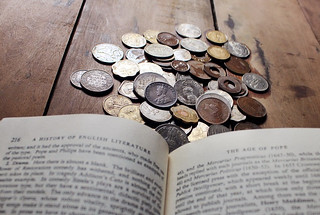 Whitman Publishing seeks to hire an editor to work on books in the antiques-and-collectibles and American history fields. The position is full-time and on-site in the company's Pelham, Alabama, office (just outside Birmingham).
Whitman Publishing seeks to hire an editor to work on books in the antiques-and-collectibles and American history fields. The position is full-time and on-site in the company's Pelham, Alabama, office (just outside Birmingham).
A degree in a subject related to publishing (e.g., English, communications, writing) is required; and a strong background in technical writing, scientific writing, or cataloging will be useful.
For the main project involved in this position, the associate editor will fulfill all editorial duties, from macro to micro: project management (including managing processes, files, and people [freelance writers, subject-matter experts, and others]), writing, copyediting, photo research, editing spreadsheets and converting data to composition-ready Word files, and proofreading laid-out pages.
It's a challenging but rewarding position for the right person. See the article online for more, including the refreshingly transparent optional qualification of "Proven ability to work with a variety of authors, from novice to highly experienced, and from good-natured to cantankerous." -Editor
To read the complete article, see:
Whitman Publishing seeks a full-time associate editor
(http://news.coinupdate.com/whitman-publishing-seeks-a-full-time-associate-editor/)
To read the earlier E-Sylum article, see:
STACK'S BOWERS GALLERIES IS HIRING
(https://www.coinbooks.org/v24/esylum_v24n45a16.html)
COLONIAL COIN COLLECTORS CLUB 2021 AUCTION
It's that time of year again - the Colonial Coin Collectors Club auction. Here's a blog article from Stack's Bowers. -Editor
Stack's Bowers Galleries is pleased to once again present a dedicated colonial and early American coins session in our November 2021 Showcase Auction. This year marks the 10th year we have presented this official auction of the Colonial Coin Collectors Club (C4), held in conjunction with the C4 National Convention. This year's sale features an exciting array of colonial and pre-federal coins, including long off the market collections, significant new discoveries, and well pedigreed rarities across a variety of series. The offerings span from Massachusetts silver to desirable state coppers and early Washington pieces, with many exciting items in between.
The Norm Peters Collections of New Jersey and Connecticut Coppers feature numerous choice and rare specimens to collectors of these two popular series, and includes an incredibly rare 1787 New Jersey Maris 62-r. The Pierre Fricke Collection of Fugio Coppers will mark the first major auction appearance of a 50-variety set of this historic coinage. Enthusiasts will be excited by such incredible rarities as AU-55 (PCGS) examples of the 1787 Fugio Newman 10-T and Newman-11-A.
Many other significant properties will be offered in addition to these two special cabinets. There is remarkable selection of pieces from the collection of respected dealer Richard Rossa, formerly of Rossa and Tanenbaum, as well as a newly discovered 1658 Lord Baltimore shilling and a rare 1790 Standish Barry threepence. Whether you're a newcomer to the fascinating world of colonial numismatics looking to dip your toe in, or a seasoned veteran with an advanced collection, there should be something for you in the lots to follow. Enjoy the auction and thanks in advance for your participation.
To read the complete article, see:
Early American Coins Featured in the Stack's Bowers Galleries November 2021 Auction: The Official Auction of the Colonial Coin Collectors Club
(https://www.stacksbowers.com/News/Pages/Blogs.aspx?ArticleID=c4-coin-auction-in-november-2021-showcase-auction)
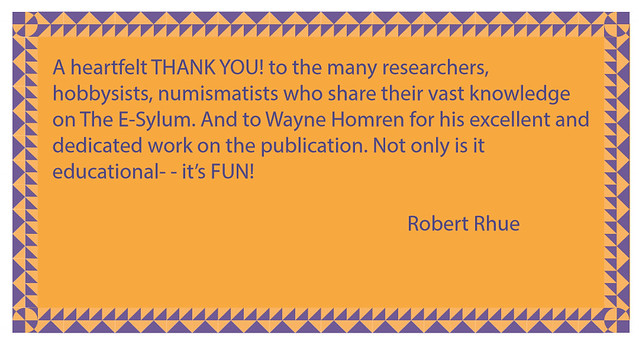
2013 SILVER LEALANA 0.1 BITCOIN OFFERED
Last month we discussed the "Gold Cas", the one-ounce gold coin with a denomination of 1,000 Bitcoins. This Stack's Bowers press release discusses the much smaller denomination Silver Lealana 0.1 Bitcoin. -Editor
Stack's Bowers Galleries is excited to present a physical Lealana Bitcoin in lot 4151 of their November 2021 Showcase Auction. Graded SP-70 by PCGS, it is the very first bitcoin from the Lealana series to be certified by that service and will also be the very first piece of physical cryptocurrency offered in a major live auction. It features an intrinsic face value, or peel value,
of 0.1 Bitcoin (BTC), equivalent to roughly USD$6,500 at the time of publishing. With a current high-bid of $7,000 and two more weeks remaining before it crosses the auction block in Costa Mesa, California, enthusiasm among aficionados of cryptocurrency and traditional numismatists is strong for this new and exciting numismatic category.
This physical Lealana Bitcoin represents a historic revolution in commerce, similar to the first gold coinage issued by King Croesus circa 500 BC and the first U.S. coins to be struck by steam press in 1836. It is the physical manifestation of an entirely digital concept, offering a fusion of numismatic utility and financial technology.
First introduced as Lealana Litecoin, the Lealana series was released to collectors and investors in June 2013 as a counterpart to the Casascius physical bitcoins introduced in 2011. It was invented and issued by Noah Luis of Honolulu, Hawaii, who is perhaps better recognized within the crypto community by his internet handle smoothie.
These physical Lealana Bitcoins were produced in both brass and silver compositions and issued in a range of denominations from 0.1 BTC to 1 BTC, corresponding to those of the Casascius series. Only 2,000 Lealana 0.1 Bitcoins were issued in silver, and this buyer-funded example with a black address is a great rarity, one of only 10 issued. It is considered part of the limited Series 1 Lealana coins, offered before the address color was changed to green in May 2014 to comply with regulations.
The value of this SP-70 (PCGS) coin was buyer-funded and remains unredeemed, further increasing its desirability. Issued on a 25mm planchet of ¼ ounce of .999 fine silver and minted by Northwest Territorial Mint, the obverse features a holographic sticker with the serial number at left and the public address visible through a rectangular window. On the reverse is the Bitcoin currency symbol at center surrounded by a legend listing the denomination, composition, and the Hawaiian phrase IKAIKA I HELU NUI
that translates as Strength in Numbers.
Also included with this physical Lealana Bitcoin is a Certificate of Authenticity (COA) and an encased Pretty Good Privacy (PGP) message.
Fierce competition among both collectors and investors is anticipated when the bidding goes live for this SP-70 (PCGS) Lealana 0.1 bitcoin in Stack's Bowers Galleries' November sale.
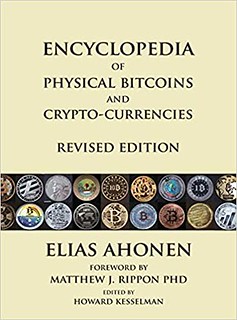
Last week we discussed Elias Ahonen's book on physical bitcoins. I ordered one, and I'm glad I did. It's very well written and produced, and provides a handy guide to the wide variety of tangible representations of the intangible. -Editor
To read the complete lot description, see:
2013 Silver Lealana 0.1 Bitcoin (BTC). No. 3605. Series 1. Unredeemed. Buyer Funded. Black Address. ¼ Troy Ounce .999 Silver. 25mm. SP-7...
(https://auctions.stacksbowers.com/lots/view/3-TYP2B/2013-silver-lealana-01-bitcoin-btc-no-3605-series-1-unredeemed-buyer-funded-black-address-troy-ounce-999-silver-25mm-sp-7)
To read the earlier E-Sylum article, see:
2012 GOLD CASASCIUS 1000 BITCOIN GRADED
(https://www.coinbooks.org/v24/esylum_v24n41a12.html)
NEW BOOK: ENCYCLOPEDIA OF PHYSICAL BITCOINS
(https://www.coinbooks.org/v24/esylum_v24n45a05.html)
DAVISSONS E-AUCTION 42
Allan Davisson wrote this overview of his firm's upcoming E-Auction. I added some lot images for illustration. -Editor
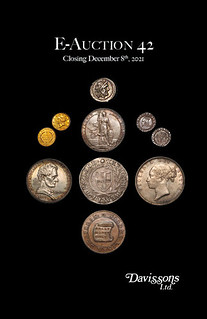 E-Auction 42, closing Wednesday, December 8th 2021, is online now! Print copies were sent over the weekend, if you are not on our mailing list and would like a copy please let us know.
E-Auction 42, closing Wednesday, December 8th 2021, is online now! Print copies were sent over the weekend, if you are not on our mailing list and would like a copy please let us know.
‘Twas a dark and stormy time….
We received an unusual consignment for this sale—a group of United States coins minted in 1853. All the gold issues (the first $3 gold piece was issued in 1854), and a choice large cent. I became fascinated by what must have been happening in this year that usually has no particular historic resonance.
The year 1853 was a time of tension and uncertainty. It was an era where things were happening in the United States—the Gadsden Purchase of land from Mexico that expanded the southern parts of modern day Arizona and New Mexico, the arrival of Commodore Perry in Japan seeking trade and consequently opening
Japan to the West, the Crimean War that resulted in the defeat of the Russian Empire and Florence Nightingale's introduction of modern nursing practices. On a more mundane level, Levi Strauss and Otis Elevator began business along with the predecessor firm for Traveler's Insurance.
It was also a time when all was not well in America. The 1850's were plagued by sectionalism,
strong feelings of threat and defensiveness that divided the country. In many respects it was a split of the sort that has its parallels now, the urban—rural split or, stated in a 21st century taxonomy, the coasts
versus the flyovers.
It was a period when individuals and groups felt that the fabric of their lives was under threat by others. It had economic elements, cultural elements, religious elements…
The final devastating outcome was the Civil War that began a few short years later.
It was a time of uncertain leadership as well. Two presidents whose names are known, at best, in passing were unable to bring a workable resolution to the national unrest. Millard Filmore, an accidental
president succeeded the distinguished Zachary Taylor who died after 16 months in office. He became the namesake of the Millard Fillmore Society whose annual meeting on his birthday is held for the single purpose of celebrating his anonymity.
Franklin Pierce, inaugurated in March 1853, mishandled the Kansas question of allowing slavery in the territory despite the Missouri Compromise of 1820 which had prohibited it. The ultimate outcome was the formation of the Republican Party, a northern antislavery party that a few short years later was the party of Abraham Lincoln.
(I have no comment on the most recent pair of American presidents and the times we are in. History is long and time tempers our passions and our understandings. We must wait.)
The rest of the catalog has some neat things—fascinating ancient silver and bronze, Roman portraiture from the provinces, affordable Scottish coins along with a section of British hammered and milled pieces, more high quality tokens from the Sussman collection, a few choice Canadian pieces, a long offering of circulated and fascinating German talers, a few U.S. pieces, and some neat odds'n'ends to end the sale.
To view the complete sale, see:
https://davcoin.com/sale/E-Auction%2042


NUMISMATIC NUGGETS: NOVEMBER 14, 2021
Here's a selection of interesting or unusual items I came across in the marketplace this week. Tell us what you think of some of these. -Editor
Bruttium, Kaulonia. Silver Stater, c. 530-510 BC. Obverse: ??V??, archaic Apollo standing right, small running figure on outstretched left arm. Reverse: Incuse of obverse. Very Fine. (SNG 153/155). 7.33g.
From the Baldwin's site. -Editor
To read the complete lot description, see:
BRUTTIUM, KAULONIA, SILVER STATER
(https://www.baldwin.co.uk/product/bruttium-kaulonia-silver-stater/)
George III (1760-1820),gold Guinea, 1791, fifth laureate head right, GEORGIVS .III. DEI.GRATIA,rev.spade shaped crowned quartered shield of arms, date below, legend reads in abbreviated Latin commencing lower left M.B.F. ET. H. REX. F.D. B.ET. L. D. S. R. I. A. T ET. E. weight 8.38g (Schneider -; Bull EGC 719; MCE 395; Farey 1300; S.3729).Toned, some light marks, hairline in reverse field, good very fine to almost extremely fine.
The Latin legends translate to on obverse "George III by the Grace of God" continuing on the reverse in abbreviated Latin which if in shown in full reads "Magnae Britanniae Franciae et Hiberniae Rex Fidei Defensor Brun et Lunebergen-sis Dux, Sacri Romani Imperii Archi-Thesaurius et Elector" and translates as "King of Great Britain, France and Ireland, Defender of the Faith, Duke of Brunswick and Luneberg, High Treasurer and Elector of the Holy Roman Empire."
From the Sovereign Rarities site. -Editor
To read the complete lot description, see:
GEORGE III 1791 GUINEA, FIFTH HEAD, SPADE TYPE REVERSE
(https://www.sovr.co.uk/george-iii-1791-guinea-fifth-head-spade-type-reverse-fm21182.html)
George Washington Centennial silvered copper commemorative tray centering a "Comitia Americana" medallion of his profile in raised relief 13" x 11"
Interesting item - I can't say I've ever seen one of these. Would anyone know where or when these were made? -Editor
To read the complete lot description, see:
G. WASHINGTON CENTENNIAL PLATED "COMITIA AMERICANA" TRAY
(https://live.clars.com/lots/view/1-57S5AQ/g-washington-centennial-plated-comitia-americana-tray)
HAWAII CENT *** Colorful Hawaiian cent. Hues of green and gold enliven the surfaces and eye appeal.
From the Harry Laibstain Rare Coins site. -Editor
To read the complete lot description, see:
1847 1C HAWAII HAWAII CENT *** PCGS MS62BN
(http://hlrc.com/Inventory/CoinViewer?id=870519002&c=23)
Apollo 7 Flown Silver Robbins Medallion, Serial Number 25, Directly From the Estate of Comedian Bill Dana. This 32mm x 24mm sterling silver medal was one of only 255 flown aboard Apollo 7, the first manned mission in the Apollo program, October 11-22, 1968, with crewmembers Wally Schirra, Donn Eisele, and Walt Cunningham. It was an eleven-day Earth-orbital mission, the first manned launch of the Saturn IB launch vehicle, and the first three-man American space launch. The obverse of the medal features the mission insignia depicting a command service module, engine firing with the trail from that fire encircling a globe and extending out, symbolizing the Earth-orbital nature of the mission. The Roman numeral "VII" appears in the South Pacific Ocean and the crew's names appears on a wide arc at the bottom. The reverse features the date of the launch, serial number 25, and the sterling and Robbins hallmarks (faint).

This one sold for $3,500 at the Heritage November 12, 2021 sale.
I'm old enough to remember Dana (born William Szathmary) from his no-longer-politically-correct appearances on the Ed Sullivan Show (in the tradition of Andy Kaufman "Foreign Man" and Sacha Baron Cohen "Borat") "in the guise of a heavily accented Bolivian character named José Jiménez. Dana often portrayed the Jiménez character as an astronaut." - Wikipedia. -Editor
To read the complete lot description, see:
Apollo 7 Flown Silver Robbins Medallion, Serial Number 25, Directly From the Estate of Comedian Bill Dana. ...
(https://historical.ha.com/itm/explorers/space-exploration/apollo-7-flown-silver-robbins-medallion-serial-number-25-directly-from-the-estate-of-comedian-bill-dana/a/6244-50137.s)
To read the earlier WIkipedia article, see:
https://en.wikipedia.org/wiki/Bill_Dana
For an obituary of Bill Dana, see:
Bill Dana, comedian who played astronaut José Jiménez, dies at 92
(http://www.collectspace.com/news/news-061917a-obituary-bill-dana-jose-jimenez-astronaut.html)
Short History of Paper Money
William Gouge's Short History of Paper Money
is a rare 19th-century treatise on state banks, American banking systems, and economics. Gouge describes the common abuses of banks, the establishment of banks in New England, and making money and bank notes. This book even includes a short section on domestic trade with Indians!
Schlib Antiquarian booksellers is offering a nicely bound copy of Gouge, one of the earliest books on U.S. numismatics. -Editor
To read the complete lot description, see:
1833 1ed History of Paper Money William Gouge American Economics Banking Indians
(https://www.schilbantiquarian.com/product/1833-1ed-history-of-paper-money-william-gouge-american-economics-banking-indians/)

CANADA'S OLDEST ENGLISH COIN?
An unremarkable coin found in a remarkable place: uncovered in Newfoundland, this Henry VII half groat could be the oldest English coin found in Canada. -Editor
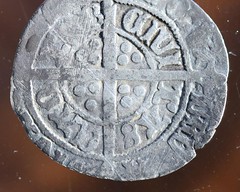 An archeological fieldworker excavating a site in eastern Newfoundland has unearthed what could be the oldest English coin ever found in Canada.
An archeological fieldworker excavating a site in eastern Newfoundland has unearthed what could be the oldest English coin ever found in Canada.
William Gilbert, head archeologist and supervisor at the Cupids Cove Plantation Provincial Historic Site, says one of his colleagues found the silver coin in September, adding that research has confirmed it was minted sometime between 1493 and 1499.
It's important because it sparks your imagination,
Gilbert said in an interview Wednesday. The coin, he added, is more than a century older than Cupids, founded in 1610. You just have to wonder when you look at this thing: how many hands did it pass through?
Known as a Henry VII ‘half groat,' or twopenny piece, the nickel-sized coin was minted in Canterbury, England, more than 500 years ago. Gilbert said he came to that conclusion after consulting Paul Berry, former curator of the Bank of Canada's Currency Museum.
The coin features a stylized portrait of King Henry VII and a Latin inscription that says, Henry, by the grace of God, King of England and France.
The other side features a cross and the king's motto, also in Latin: I have made God my helper.
Settled by Bristol, England, merchant John Guy, the Cupids plantation is the site of the oldest English settlement in Canada. The English colony at Jamestown, Va., was settled in 1607. By 1613, Guy and a small group of colonists had built several structures, including Canada's first sawmill and brewery.
Meanwhile, research on the coin is ongoing. It is expected to be put on display in time for the historic site's 2022 tourist season.
It is incredible to imagine that this coin was minted in England and was lost in Cupids over a hundred years later,
the province's tourism minister, Steve Crocker, said in a statement. It links the story of the early European exploration in the province and the start of English settlement.
In 2001, an Elizabethan coin — dated 1560-1561 — was found at the same site, and at the time it was considered the oldest English coin ever found in Canada.
Thanks to Howard Berlin and Paul Horner for forwarding BBC News versions of the story. -Editor
To read the complete articles, see:
Archeological dig in Newfoundland unearths what could be Canada's oldest English coin
(https://www.thestar.com/news/canada/2021/11/10/archeological-dig-in-newfoundland-unearths-what-could-be-canadas-oldest-english-coin.html)
Rare 520-year-old coin found at site of first English settlement in Newfoundland
(https://www.bbc.com/news/world-us-canada-59252280)

COMMEMORATIVE COIN TAB TONING
A nice CoinWeek article by Dan Duncan discusses the distinctive toning seen on examples of classic U.S. commemorative coins due to their storage in the original cardboard shipping holders. Here's a short excerpt - see the complete article online. Great photos! -Editor
Coins are toned when the silver oxidizes after coming into contact with foreign material and gases. The toning patterns and colors are determined by how the coins were stored, either as originally distributed or in their collected environments. Morgan dollars are known to have a textile tone from the canvas bag, and many examples display end roll toning from the folded ends of the paper wraps in which they were stored. Roosevelt and Mercury dimes can be found with a banded toning from the bank cards that encouraged account holders to save in the fifties and sixties. Of course, all silver coins can be found with target toning featuring colorful bands extending from the peripheries from years of sitting in various collector albums.
All of these examples and more are highly coveted by collectors across the spectrum of enthusiasts.
But, the classic commemoratives have a unique toning pattern imparted from the original cardboard holders in which the coins were originally distributed. Many of those sold between 1935 and 1937 were mailed in three-, five-, or six-coin cardboard holders that featured a paper strap designed to hold the coins in place. The exposed areas around the tab oxidized leaving an identifiable circle across the surfaces of the coins. Usually, the opposite side of this stenciled
pattern is toned throughout as this side was stored against the paper backing. Following is a quick discussion of the issues that can be commonly found with this tell-tale pattern.
1926–1939 Oregon Trail Memorial
This long-running issue was distributed in various ways. The coins were sold in two different cardboard holders with slots for three coins. Some of these were cut into thirds allowing for a single coin as a cost-cutting measure. One of the holders made by John H. Eggers of New York has Oregon Trail Memorial Association, Inc.
printed underneath the three tabbed slots. The other is plain with just Patented by John W. Rogers, New York
printed at the bottom. All the dates in the Oregon Trail series can be found with vibrant color and often the color appears to blend from the peripheries. But, after reviewing literally hundreds of images from our files, PCGS.com and Heritage Auctions, I have not found visual evidence that the tab toning in dates prior to 1936. This coincides with the Scott Stamp and Coin Company taking over the reins in distribution.
To read the complete article, see:
The Tab Toning of Classic US Commemorative Coins
(https://coinweek.com/us-coins/the-tab-toning-of-classic-us-commemorative-coins/)

THANKSGIVING VIGNETTES
In the U.S., the Thanksgiving holiday will soon be upon us. John Ferreri kindly submitted this timely article about Thanksgiving vignettes on obsolete paper money. -Editor
An Historic American Event
C. John Ferreri
On Sept 16th , 1620 a group of 102 men and women set out from Plymouth, England to start a new life in northern Virginia. They came close but actually ended up on the shores of Cape Cod in what would later become, the State of Massachusetts. They were escaping church prosecution and hoped to be able to live by their own beliefs here in this new land. They anchored their ship, the Mayflower, off Provincetown, Massachusetts and made a few day trips to explore the shore to see if it could help sustain them.
While on board and actually
before they proceeded another few miles across the bay to the distant
shore of Plymouth, they drew up, agreed to live by, and signed a
document that became their first constitution which we now know as
the Mayflower Compact. The Mayflower's main cabin became the
study where this compact
was drawn up and signed by John Carver,
Wm. Bradford, Wm. Brewster, Myles Standish, John Alden and 36 other
adult males who were considered to be the true
Pilgrims on board.
The title of this article is the opening statement of that Compact
. The
main vignette of the note shown above is an artist's engraving of that
probable scene on board the Mayflower. The caption under the image,
above is the actual title of the engraving executed by Toppan,
Carpenter and Company, banknote engravers.
A group of the Pilgrims has gathered to meet a representative of a
native tribe of indigenous people. This vignette is a copy of the 1818 painting,
The Landing of the Pilgrims
by Henry Sargent. A key
is available identifying
each of the subjects portrayed including even, Peregrine White, the infant being
held by his father ascending the hill behind the group.
The ship, Mayflower may be seen in the background and Pilgrims coming ashore to join with others readying a tent and preparing food. Note the Pine Tree to the right with a Native American approaching below and an Osprey above, keeping an eye out for errant bits of food. The date, 1620 appears in the sand to the left of the tree on this plate executed by the New England Banknote Company about 1835.
The scenes depicted on these three banknotes are of the earliest American historical event captured on some issues of our early paper money, before the advent of federally issued paper money. These have become a text of images and a source of knowledge for those interested in learning about their origin.
During this Thanksgiving season it is customary to give thanks for our good fortunes just as the Pilgrims before us and as collectors we could also give thanks for the foresight shown by the early bankers, artists and engravers when executing these historic images.
Thanks, given. -Editor
THE BOOK BAZARRE
PANDEMIC EFFECTS ON BRICK-AND-MORTAR SELLERS
Worthpoint's Worthopedia is a great service for pricing data for collectibles, including coins. Worthpoint also publishes interesting newsletter articles on various collectibles. A November 8th piece by Jack Rose about the effects of the pandemic on brick-and-mortar antique sellers probably rings true in the numismatic world as well. Here's an excerpt - see the complete article online. -Editor
The effects of COVID-19 on the U.S. economy are far-reaching. Jobs were lost, businesses went under, entire industries were shaken to their cores.
One of the most pronounced effects of COVID-19 has been the push to move processes to the digital space. As a result, people are working from home, online shopping has skyrocketed, and physical retail spaces have been hurting.
So just what have been the effects of COVID-19 on brick and mortar antiques retailers? Well, it's a mixed bag of the good, the bad, and the ugly.
The Good
 Perhaps the most significant change for antique retailers is an increase in thrifting and antiquing by younger generations.
Perhaps the most significant change for antique retailers is an increase in thrifting and antiquing by younger generations.
Millennials and younger are well-equipped for the world of digital shopping. As antique retailers shifted toward selling online, they discovered an untapped wealth of ready-to-buy young customers.
Younger generations have always been known for thrifting. A study conducted by Piper Sandler found that 51% of teens had purchased secondhand clothing, so they are familiar with the process. The new emphasis retailers have placed on online selling has been a boon, sometimes exceeding their numbers pre-COVID.
But it's not just young folk doing all the heavy lifting. As more people work from home, they are starting or finishing long-overdue projects. Maybe they're tired of the particle-board coffee table they've had since college. Perhaps they're ready to go out to look for that one piece that will really tie a room together.
Regardless, people are spending time at home and are tired of looking at their stuff. As a result, many antique stores have reported a sharp uptick in the amount of furniture they're moving. Practical pieces, such as desks and end tables, have been flying off the shelves as traditional furniture retailers have struggled.
The Bad
COVID-19 has leveled many small, institutional businesses across America. This was particularly true in the early days of the pandemic, when companies faced unexpected, extended shutdowns.
Many small antique retailers already had thin profits, but they were sufficient to stay afloat. However, they were unprepared for months-long shutdowns, and these restrictions ended up killing their businesses. Suddenly cut off from customers and revenue, small retailers across the country closed their doors permanently or temporarily in the wake of pandemic regulations.
The nature of antiques retailing is what made so many of them vulnerable. Antiques retailers are, by definition, unessential businesses. They sell discretionary items, many of which have little functional application. On top of this, many small retailers didn't have the number of employees required to apply for government subsidy programs.
Essentially, they fell through the bureaucratic cracks and were left mainly to their own devices.
But online shopping is still an option, right? So why didn't they make the switch to a digital platform like so many other retailers did?
Well, not everyone is equipped to sell in the digital space efficiently. For example, a mom-and-pop retailer may not have the knowledge or resources required to set up an online store. If they can accomplish that, they must generate interest, market their inventory, handle online sales, ship to various locations, and still turn a profit. Such businesses were already hurting, and shifting to online selling would tax their thin resources even further. Those few months of less-than-normal sales alone could be enough to kill off a business.
Storefront coin businesses have been on the decline for years. Are readers aware of any that have opened or closed since the beginning of the pandemic? -Editor
To read the complete article, see:
THE EFFECTS OF COVID-19 ON BRICK AND MORTAR ANTIQUES RETAILERS
(https://www.worthpoint.com/articles/business/the-effects-of-covid-19-on-brick-and-mortar-antiques-retailers)

VENEZUELAN ARTIST PAINTS OLD BANKNOTES
Artists and craftsmen often repurpose obsolete banknotes, especially in nations hard-hit with hyperinflation. Here's a new story about an artist in Venezuela making use of the country's worthless banknotes. -Editor
Venezuelan artist and medical student Elianni Di Gregorio is using old bolivar notes as canvas for her paintings as she strives to give them new value after rampant hyper inflation and successive overhauls saw them discarded.
Di Gregorio, 24, decided to paint on bolivar notes thrown away in the trash to restore some of the currency's former glory.
Three monetary overhauls since 2008 have cut up to 14 zeros from the currency, pushing vast quantities of notes out of circulation. The most recent overhaul took place in October, when Venezuela's central bank wiped six zeros from the bolivar.
"I could see how they were throwing incredible amounts of paper money in the trash, which affected me greatly, which is why I decided to reuse them for a different purpose and began to paint on them," said Di Gregorio, who has used the banknotes as her main canvas since 2017.
In one of her paintings Di Gregorio used a pink 20-bolivar note to reproduce La Fornarina, which depicts a semi-nude woman in one of renaissance artist Raphael's most important works.
To read the complete article, see:
Venezuelan artist brings new value to discarded banknotes
(https://www.channelnewsasia.com/cna-lifestyle/venezuelan-artist-brings-new-value-discarded-banknotes-2310101)

GIZMO'S PAINTING ACCEPTS DOGECOIN!
On Facebook John Kraljevich writes:
"Someday, there will be invisible secret money that only exists as bits of computer code.
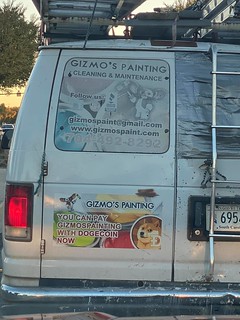 "People will make fun of that weird invisible money by creating their own invisible money that's named after a famous funny Internet dog.
"People will make fun of that weird invisible money by creating their own invisible money that's named after a famous funny Internet dog.
"Anyway, you'll be able to hire a painter with that."
This year my son gave me cryptocurrency for my birthday. Mind you, for grins I already have some in my PayPal account (Bitcoin and Ethereum), but I had to set up CoinBase to accept his gift of Cardano ADA coins. Does Gizmo accept those for small jobs up in Virginia?
These are the Wild West days of electronic money, like the wildcat banking era before the National Bank Act. Everybody has their own crypto money, with varying methods to store and spend it, and limited choices on who will accept it. Someday there will become a consensus and standard, but buckle up folks - it's going to be a bumpy ride. -Editor
To see the Facebook post, see:
https://www.facebook.com/photo.php?fbid=10227998307962843
And right on cue, here's an article about the Mastercard crypto card. -Editor
 Mastercard partnered with cryptocurrency finserv platforms Amber Group, Bitkub, and CoinJar to launch crypto payment cards in Asia-Pacific, per a press release. The cards will convert digital tokens into fiat currency that can be used anywhere Mastercard is accepted. The initiative is part of Mastercard's global crypto card program, which seeks to support native digital currencies as payment tools.
Mastercard partnered with cryptocurrency finserv platforms Amber Group, Bitkub, and CoinJar to launch crypto payment cards in Asia-Pacific, per a press release. The cards will convert digital tokens into fiat currency that can be used anywhere Mastercard is accepted. The initiative is part of Mastercard's global crypto card program, which seeks to support native digital currencies as payment tools.
Major financial institutions—like JPMorgan, Wells Fargo, and Capital One—increased crypto talent hiring by 40% in the first half of 2021 compared with the same period last year, per LinkedIn data. Facilitating crypto payments may therefore be an attempt to keep issuers tied to Mastercard's network as they start thinking about offering crypto services.
To read the complete article, see:
Mastercard will launch crypto cards in Asia amid heightened local demand for digital currencies
(https://www.emarketer.com/content/mastercard-will-launch-crypto-cards-asia-amid-heightened-local-demand-digital-currencies)
Mastercard launches credit card with cashback in cryptocurrencies
(https://olhardigital.com.br/en/2021/04/27/pro/mastercard-lanca-cartao-com-cashback-em-criptomoedas/)

LOOSE CHANGE: NOVEMBER 14, 2021
Here are some additional items in the media this week that may be of interest. -Editor
The latest Mike Markowitz article in his CoinWeek Ancient Coin Series is on "The Archaic Smile on Ancient Coins". -Editor
ANCIENT GREEK COINS struck before 500 BCE are called archaic
by numismatists. Actually, archaic features continue to appear on coins for at least another century or so. Male and female faces on many of these coins bear a faint, enigmatic smile, something that is also found in sculpture and vase painting from this era. For centuries, art historians have been fascinated by this Archaic Smile
, and many different theories have been proposed to explain it.
An early example is found on a 2.57 gram electrum hekte (one-sixth stater) of Phokaia (or Phocaea), a coastal town in Ionia (on the eastern shore of the Aegean Sea). Dated to c. 521-478 BCE, the coin bears a female head wearing a helmet or close-fitting cap.
The only female figure in ancient art usually depicted wearing a helmet is Athena, in her aspect as a war goddess. On the coin, her full lips are slightly upturned, and although the head is shown in profile, the large almond-shaped eye appears as if viewed frontally. This is a standard feature of archaic portraiture.
To read the complete article, see:
The Archaic Smile on Ancient Coins
(https://coinweek.com/ancient-coins/the-archaic-smile-on-ancient-coins/)
CoinWeekly published an article by Michael Alexander about the face value of collector coins. I haven't heard yet of any instances in the U.S. of people spending recent commemorative coins at their ostensible face value. -Editor
To read the complete article, see:
Is Paying With Collector Coins A Crime in the UK?
(https://coinsweekly.com/is-paying-with-collector-coins-a-crime-in-the-uk/)
To read the earlier E-Sylum article, see:
NOTES FROM E-SYLUM READERS: NOVEMBER 7, 2021 : Commemorative Legal Tender Coins Spent in the U.S.?
(https://www.coinbooks.org/v24/esylum_v24n45a13.html)
In his Coin Collectors Blog Scott Barman noted an update to the Semiquincentennial Commemorative Coin Act. -Editor
 On Friday, the Government Printing Office updated S. 2384, the Semiquincentennial Commemorative Coin Act, to include a summary. If passed, the bill will create a commemorative coin program in 2026 to celebrate the 250th anniversary of declaring our independence from England.
On Friday, the Government Printing Office updated S. 2384, the Semiquincentennial Commemorative Coin Act, to include a summary. If passed, the bill will create a commemorative coin program in 2026 to celebrate the 250th anniversary of declaring our independence from England.
To read the complete article, see:
LEGISLATIVE UPDATE: Semiquincentennial Commemorative Coin Act
(http://coinsblog.ws/2021/11/legislative-update-semiquincentennial-commemorative-coin-act.html)
The medals of a South African WWI pilot are being auctioned. -Editor
The Distinguished Flying Cross earned by a teenage RAF pilot who downed a First World War German ace is going under the hammer later this month.
Richard Winterton Auctioneers, Tamworth, is auctioning the rare piece of history with other medals awarded to Lieutenant George Edgar Bruce Lawson plus an archive of associated paperwork.
Hailing from Cape Town, Lawson was only one of eight South Africans to be awarded the DFC and was a fighter ace credited with six aerial victories.
To read the complete article, see:
Rare medal collection from WW1 pilot who downed German flying ace set to for auction
(https://www.expressandstar.com/news/local-hubs/staffordshire/lichfield/2021/11/11/rare-medal-collection-from-ww1-pilot-who-downed-german-fling-ace-set-to-be-auctioned-off/)
Bibliophiles may enjoy this New York Times article on Portland's Powell's Books, one of the largest used book stores in the U.S. -Editor
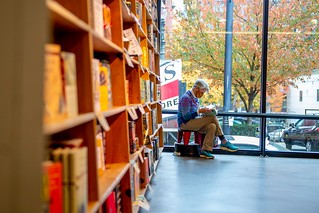 Over its half-century in the heart of Portland, Powell's Books has survived an unending array of foundational threats — the oft-anticipated death of reading, the rise of Amazon, the supposedly irretrievable abandonment of the American downtown.
Over its half-century in the heart of Portland, Powell's Books has survived an unending array of foundational threats — the oft-anticipated death of reading, the rise of Amazon, the supposedly irretrievable abandonment of the American downtown.
None of that provided preparation for the tumult of the past two years.
The pandemic shut down its stores for several months, and turned downtown into a place best avoided.
A quirky, old-school enterprise, Powell's has retained its traditional aura in the digital era, while standing as a hero in a now-familiar tale of American urban rejuvenation. Its flagship store — a grand warren of books filling out a former car dealership — anchors a once dicey neighborhood whose warehouses have been traded in for glass-fronted condos and furniture boutiques.
To read the complete article, see:
Powell's Books Survived Amazon. Can It Reinvent Itself After the Pandemic?
(https://www.nytimes.com/2021/11/09/business/powells-books-pandemic.html)

GRANDILOQUENT WORDS OF THE 19TH CENTURY
We love words here at The E-Sylum. Check out this New York Times article on the fanciful grandiloquent words of the 19th century. -Editor
Have you ever been inveigled? Bamboozled? Have you been hornswoggled by lexiphanic rodomontade? Have you fallen victim to the flummery of an ultracrepidarian?
Fear not — you can learn to parse these fanciful formations and lexical sockdolagers. You might even pick up some parlance with which to pepper your own persiflage.
We're talking about grandiloquent words, delightful colloquialisms mostly from the 19th century. John Camden Hotten's Dictionary of Modern Slang,
published in 1859, described them as vulgarisms of an indulgent public.
If you're a native speaker of American English, these words make you smile, so that means they work,
Mr. Sokolowski said. They just work.
To read the complete article, see:
Words Full of Sound and Fury
(https://www.nytimes.com/2021/11/09/crosswords/grandiloquent-words-language.html)


